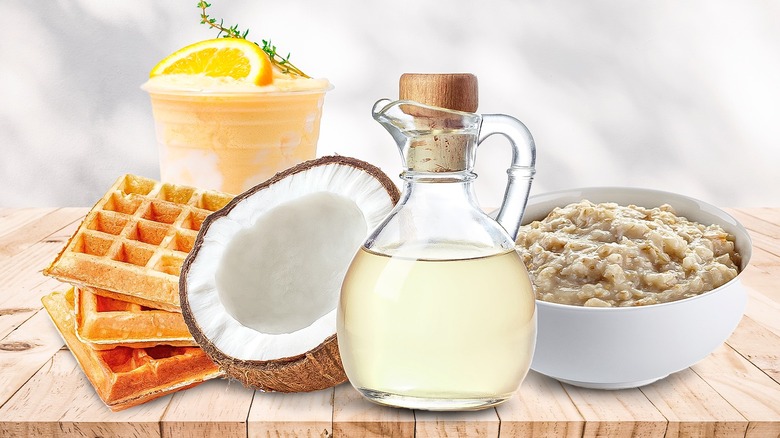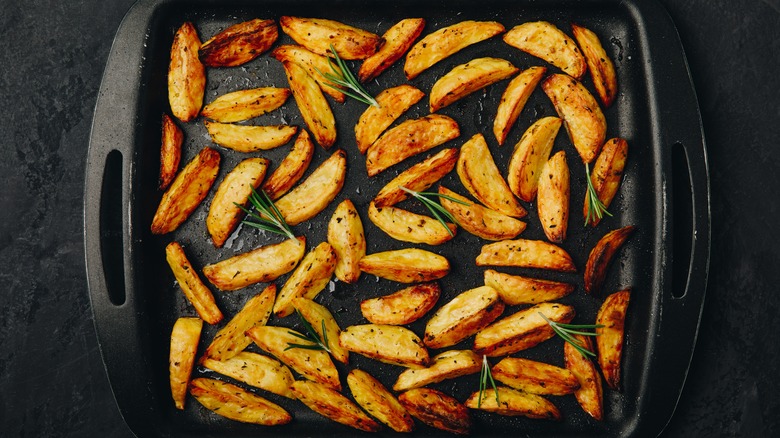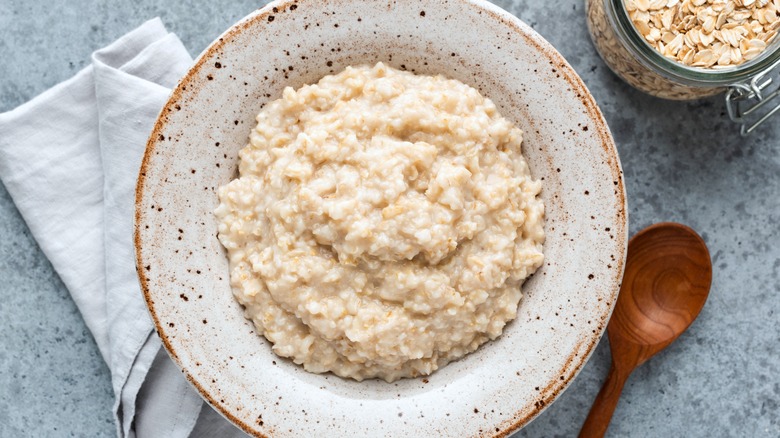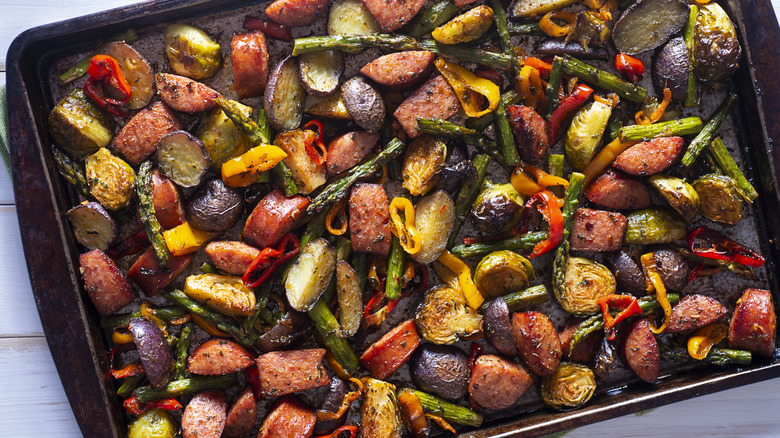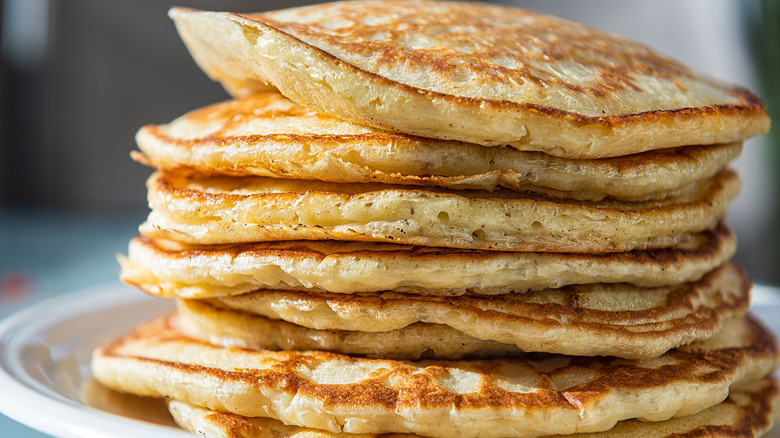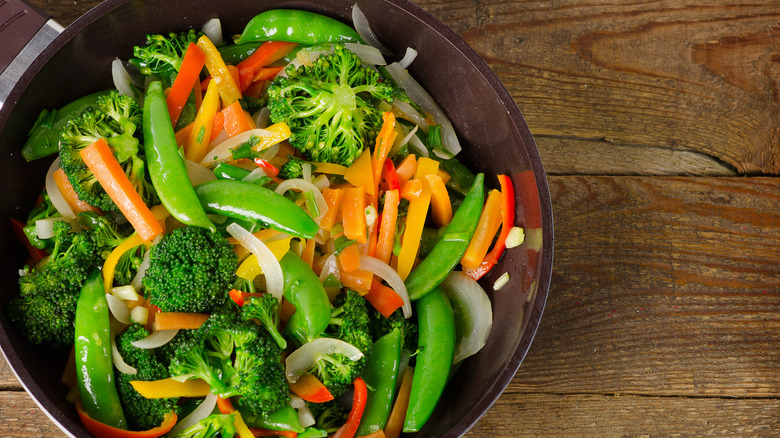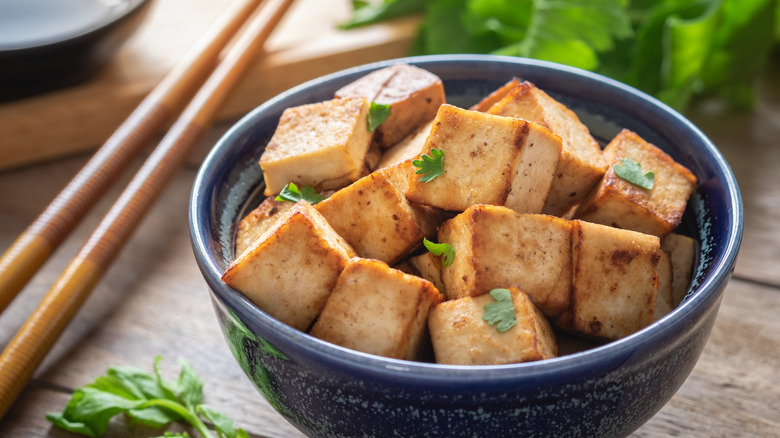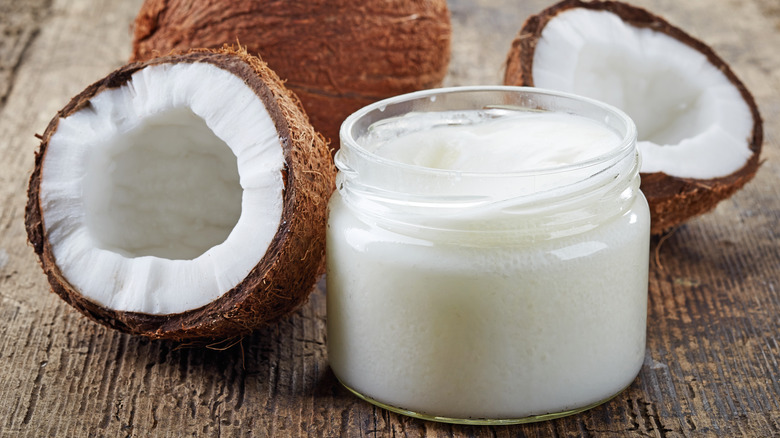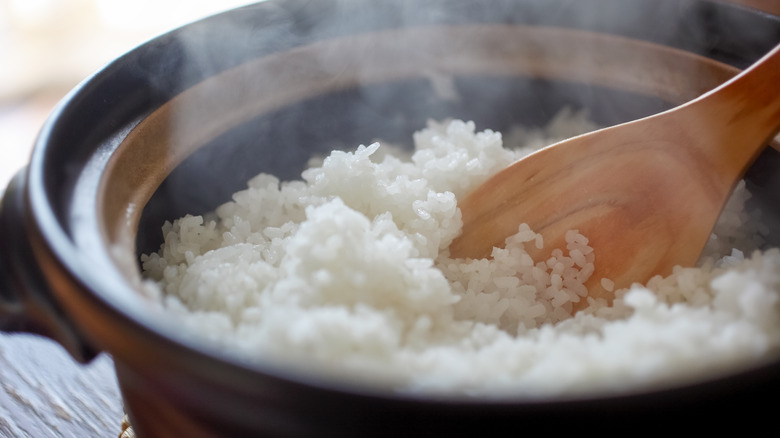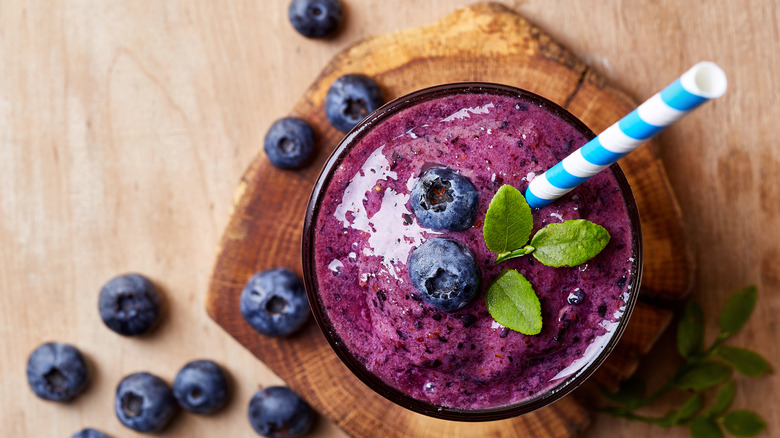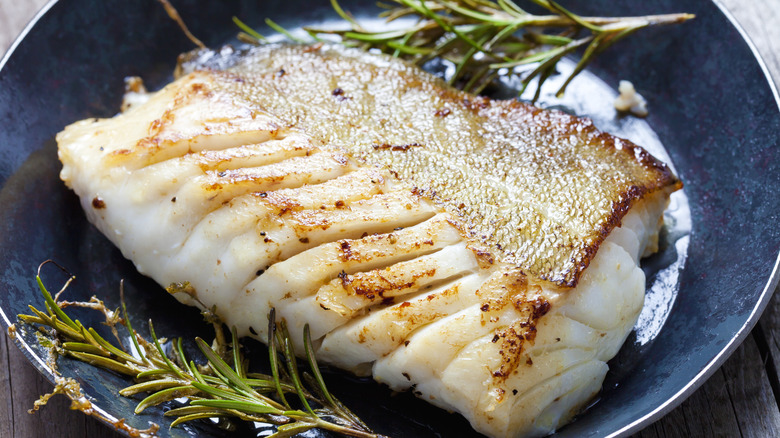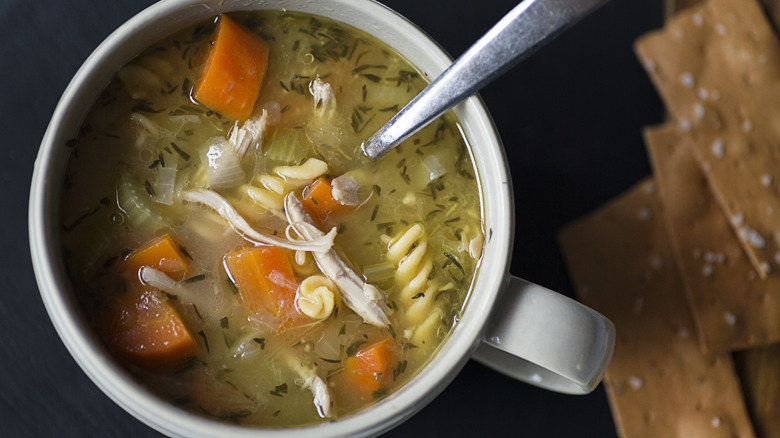14 Uses For Coconut Oil In The Kitchen
Oil is a great way to create a crispy texture, add density, and bring a balanced mouthfeel to just about any dish. It can be flavorful, buttery, and aromatic, depending on the kind you use. Extra virgin olive oil and canola oil have dominated the cooking scene, but plenty of other options are worth considering. If you have yet to explore the wonders of coconut oil, this is your sign to buy a jar for your pantry.
Coconut oil has been overlooked for far too long. Its versatility is incredible, as it can enhance both sweet and savory meals. Being made of mostly saturated fat gives it a richness closer to butter than oil, and because of this, it is often used in the vegan culinary world in place of butter. However, there are endless uses for coconut oil in everyday cooking.
When selecting your jar, keep in mind that refined and unrefined coconut oil have different flavors and smoking points. Refined coconut oil is versatile, as it has a more neutral flavor, while the unrefined version is fruitier and more aromatic. Its taste can send you straight to the tropics, and it has a lower smoke point of about 350 degrees Fahrenheit.
Add to your hot beverage
While it's not typical to add oil to hot beverages, it's a practice that has been part of Himalayan culture for centuries. Yak butter is commonly added to hot tea, which makes it rich, and is said to help with mental clarity and extreme cold weather. More recently, folks have been drinking coffee with coconut oil and butter in it. It's commonly referred to as "Bulletproof Coffee" after biohacker Dave Asprey keyed the term in the early 2000s. However, you don't have to live on a frigid mountain or even keep up with the latest biohacking trends to use coconut oil in your hot beverage.
Simply add a teaspoon or less of refined or unrefined coconut oil to hot chocolate, tea, coffee, or turmeric golden milk. Not only will the flavor of your drink linger on your tongue, but it will have a fatter, richer taste. Coconut oil is safe to drink, but because of its high saturated fat content, it's recommended to refrain from consuming more than 2 tablespoons at a time. It works best in hot beverages because it solidifies at room temperature, so don't go whisking it into your lemonade or iced tea.
Coat your baked fries
Although coconut oil sounds like a specialty ingredient you might use to make Bananas Foster or some other kind of complicated baked fruit dish, it is actually quite versatile and can be employed in everyday cooking. Next time you whip up a batch of french fries in your air fryer or oven, use refined coconut oil. It has a smoke point of 400 degrees Fahrenheit, and its rich, fatty flavor only adds to the experience. Because refined coconut oil has a neutral flavor, your fries won't taste tropical. Instead, you can focus on the flavor of the potato and any seasoning you might add.
Because coconut oil is mostly saturated, it is solid at room temperature. To coat your fries evenly, warm the oil up slightly on the stovetop or in the microwave. It will also melt immediately in your warm hands, so if you usually toss your chopped potatoes by hand, then dollop a soft scoop right onto the cut potatoes. Use any old oven or air fryer french fry recipe, and simply replace your cooking oil with refined coconut oil. Coconut oil dominates canola oil in the french fry department. Once you give it a try, you'll never turn back.
Increase the richness of your oatmeal
Does your oatmeal feel like it's just missing something? You can't just heat oats with water, milk, or non-dairy milk and expect fireworks. There are endless tips you need to make the perfect bowl of oatmeal, but we can break it down fairly simply. Your oats need a little sugar, a little salt, and a little fat to help them sing. Maple syrup is a natural go-to for sugar, but brown sugar and honey are fair alternatives. Salt can come from table salt or salted butter. But the combination of unrefined coconut oil, maple syrup, and sea salt takes the cake.
This creates a base with a balanced mouthfeel that is prepared to carry any other toppings you may have in mind. The coconut oil adds a heartiness and a subtle flavor that is irresistible. If you are in the mindset that oatmeal is not appealing, then you are doing it wrong. You wouldn't eat a bowl of rice without any seasoning, so why would you do that with oatmeal? It's simply a blank canvas, ready to be flavored, and coconut oil does the trick. Load up with berries, nuts, seeds, or any other topping of your choice once you have your oat recipe down.
Fry your eggs in it
It's so easy to fall into a breakfast rut. Do you take your eggs scrambled, fried, or over easy? These three variations dominate the breakfast scene. Perhaps on the weekends, you'll make a frittata or omelet. Eggs are typically the staple of breakfast in the United States and many other cultures. They are incredibly versatile, but there are so many ways to make your eggs taste even better. Both refined and unrefined coconut oil do the trick, so it really just comes down to personal preference in the flavor department.
Although fats are typically used to help with cooking and texture, the flavor is important, too. If you're used to employing salted butter, be sure to grind or sprinkle some salt onto your eggs if you're switching to coconut oil. In addition, any spices you use should be added either before or while the eggs are cooking. The heat will help to elevate their flavor and fill your kitchen with fragrant aromatics. Try black pepper, sea salt, and turmeric alongside your coconut oil eggs. For scrambled eggs, consider pairing tamari or soy sauce with coconut oil.
Use it to roast vegetables
Yes, the combination of olive oil, salt, and pepper makes for a simple coating for your roasted vegetables. And there is nothing wrong with that. However, it might be beneficial to expand your culinary creativity and experiment with different cooking oils and seasonings. There are a few vegetables that are overwhelmingly elevated when coated with coconut oil and a handful that truly thrive with the flavors of unrefined coconut oil.
Use unrefined coconut oil when roasting vegetables that have a sweetness to them, like butternut squash, sweet potatoes, snap peas, onions, or carrots. Really, any root vegetable will do. Be sure to roast these at a lower temperature, ideally below 350 degrees Fahrenheit. Sometimes, just a little bit of salt alongside the flavor of coconut oil can do the trick. For vegetables with a more grassy flavor, like asparagus, broccoli, or cabbage, consider refined coconut oil and lean into your seasonings more. If you're not sure about smoke points or which type of coconut oil to use, be sure to reference our definitive guide to cooking with coconut oil.
Add it to baked goods
Even if you're a cake mix kind of baker, there is always a small amount of wiggle room for experimentation. Of course, baking is more of a science than an art, so there are rules to be followed. However, you can always choose which oil you'd like to use in your baking unless otherwise specified. In addition, when a recipe calls for unsalted butter, you can use coconut oil in its place. Both refined and unrefined tend to work well with any baked good, so give them both a taste and choose your favorite. Even unrefined coconut oil has a subtle flavor, so you can't go wrong.
Coconut oil can make your brownies incredibly dense and delicious. Consider it when baking muffins, cupcakes, cookies, or even strawberry chia oatmeal bars. You can also melt coconut oil along with chocolate chips, and it will harden when cooled. This works especially well for chocolate shells on ice cream and chocolate-covered strawberries. Use a little in your icing to help it stiffen when cooled. The options are endless when it comes to the devilish combination of coconut oil and dessert.
Grease your pan for pancakes or waffles
Coconut oil is often used as a "sweet oil," although it works in both savory and sweet capacities. Use this to your benefit by selecting unrefined coconut oil for your sweet endeavors. Pancakes and waffles can not only be cooked in coconut oil, but you can also use a small amount to top your breakfast like you would with butter. You can also use melted coconut oil in your easy pancake batter recipe.
The process remains the same. Heat your pan, add your oil, let the oil heat up, and then add your batter. Of course, you could use a nonstick pan, but there is something about that crispy edge that cooking in a little fat can add. Load up on 100% pure maple syrup, fresh or cooked fruit, whipped cream, or even jam. You can also mix melted coconut oil with peanut butter to make a fantastic drizzle for a little density and protein boost on your brunch.
Add it to your stir fry
Not sure what to make for dinner? Stir fry is always an easy option as long as you have some rice and veggies on hand. Meat, seafood, and tofu also make great additions depending on your protein preferences. While a little oil and tamari might do the trick, there are endless ways to season your stir fry. Garlic (and in abundance) is the aromatic that has everyone drooling, and spices are a no-brainer, but when it comes to selecting oil, this is your chance to get creative.
If your stir fry includes pineapple or seafood, grab a spoonful of unrefined coconut oil and get started. For your basic veggies and land proteins, consider the refined version. Even before you toss your veggies or meats in, remember that you can use coconut oil to season a cast iron pan. This will help prevent your food from sticking by creating an oil coating to seal it off. Seasoning your pan for the first time takes time and effort, but once it's established, all you need to do is give it a thin coating of oil and crank up the heat. Coconut oil also works for seasoning Blackstone grills and griddles.
Fry tofu in it
Those who don't like tofu have likely never experienced it cooked properly. You wouldn't sit around eating cold, unseasoned chicken, so why would you expect to enjoy cold, unseasoned tofu? This fermented soy product is simply a vehicle for flavor, whether that be sauces, spices, or both. Marinated tofu (like marinated meat) is utterly delicious, and you can simply use your favorite meat go-to marinades. The texture is another issue for some people, but tofu can be soft, chewy, silky, or crispy, depending on how it's prepared. Use coconut oil to tackle both departments at once.
Because tofu is so neutral, you can choose from either refined or unrefined coconut oil, although unrefined will give it that extra flavoring that tofu needs. Use it in a marinade, but be sure to warm it before soaking your tofu in the mixture. You can also use coconut oil right in the pan or coat your tofu in it before air frying or baking. This will help you achieve that nice crispy texture with a chewy inside. If you're new to the tofu scene, start with an easy tofu recipe that already has coconut oil in it. Our recipes that will make you fall in love with tofu can help.
Oil your cutting board
If you have a wooden cutting board, it's likely you will put in some effort to keep it clean. It's nice to be able to throw a plastic board in the dishwasher, but there is something special about chopping on a large wooden cutting board. There are a few methods you can use to keep your cutting boards clean, but there is one surefire way to keep it lasting quite a while. Oil it. Yes, it's that simple. This will keep it from drying out and help create a seal. In addition, a freshly oiled cutting board just looks top-tier.
Typically, linseed oil or mineral oil is used in the oiling process, but we recommend coconut oil as a great alternative. Simply blot it onto a rag or paper towel and rub a thin layer into the cutting board once it is clean. You should not see the oil pool, as it should just be enough for the wood to absorb it. Coconut oil is a great option because it's neutral in flavor and has anti-bacterial and anti-fungal properties. This makes it great for keeping your skin hydrated as well.
Use it in your grains
Grains are all too often left dry, plain, and flavorless. They weren't meant to be enjoyed like this, they deserve flavor, sauce, spice, and pizzaz. A little rice vinegar, salt and pepper, or butter can make a world of difference even if your grain is meant to take on the sauce of a curry or stir fry. A simple way to enhance any grain and give it a more pleasing mouthfeel is with coconut oil.
If you're unable to choose between refined and unrefined coconut oil, ask yourself what corner of the world your dish is from. If it's from a place that has coconut trees or includes seafood, then choose unrefined to add some coconut flavor. For all other dishes, it's safe to stick with refined, although you should always lead with your gut. The richness of the fat will elevate the grain, whatever it may be, and allow it to melt in your mouth. It adds layers of flavor and density, similar to butter.
Blend it into your smoothie
Smoothies are typically made from fresh or frozen fruit, with a few other staple ingredients, including yogurt, seeds, vegetables, nuts, oats, and nut butter. A less common ingredient that you should consider is coconut oil or coconut butter. The two are very different, as coconut butter is made from blended coconut meat, while coconut oil is pressed coconut milk, where the fat has been separated from the liquid. You can use quite a bit more coconut butter in your smoothie, as it contains fiber and less fat.
If you opt to use coconut oil, use just a small amount. A teaspoon will make a world of difference. It will add density to your smoothie, which is important if you are sticking to fruits and fruit juice, which are low in fat. Try adding unrefined coconut oil to your favorite smoothies, or choose coconut butter to elevate your smoothies to another level. You can even add it to your pina colada, daiquiri, or any tropical blended drink.
Add it to the pan when cooking fish
There are so many ways to cook fish, but most require some kind of cooking fat. There is no better oil to cook fish in than coconut oil. Unless your angle is purely Mediterranean, in which case extra virgin olive oil would be appropriate, coconut has a fresh and light flavor coupled with a dense mouthfeel that just seems to uplift seafood. Because coconut trees are typically grown near water, and fish are from the ocean or freshwater, it's no surprise that the duo just seems to work. In any situation where you might grab butter to cook with, coconut oil can take its place.
Because fish is often described as light, flakey, and delicate, it's important not to overdo it with coconut oil. There is nothing worse than greasy fish that appears overly fatty. Use just enough coconut oil in your pan to prevent the fish from sticking, and add the raw seafood to the pan only when the oil has had a chance to heat up. You can also rub coconut oil on a baking dish before adding raw fish for an oven-baked recipe. Use unrefined for ocean-caught seafood and refined for fresh-water fish.
Make your soup richer
Whether you are whipping up your famous three-bean chili, corn chowder, or chicken noodle soup, you're missing an ingredient you didn't know you needed. If you're keen on using extra virgin olive oil as a garnish, then this suggestion may be of interest. Use a small teaspoon of coconut oil in your hot soup for flavor and richness. If you are feeling hesitant about adding spoonfuls of saturated oil to your soup, then consider cooking your vegetables in it before adding broth.
Coconut milk is a staple in the creamy soup department, especially when it comes to dairy-free alternatives. However, you don't need to be making an ultra-creamy soup in order to use coconut oil. Even broth-based soups deserve a little extra fat. Any vegetarian or fish soup will taste delicious with unrefined coconut oil. In the same vein, beef or chicken-based soup, curries, and coastal cuisine work best with refined coconut oil.
However, chilled soups will not work, as coconut oil is soft but still solid even at room temperature. You may notice this when you refrigerate hot soup leftovers — but don't worry about the separation or layer of fat at the top. It will melt when heated and will just require a few quick stirs to incorporate it back into the soup.
